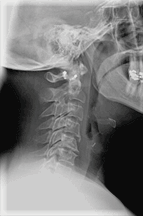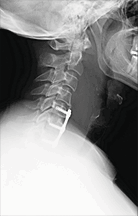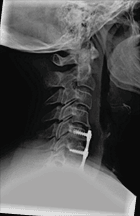Larger doses, placement of rhBMP-2 may cause anterior cervical spine complications
Surgeons said they continue off-label use of rhBMP-2 in the cervical spine for select patients.
 PHILADELPHIA — Three studies investigating the use of recombinant human bone morphogenic protein-2 in the anterior cervical spine found adverse postoperative effects, including dysphagia and swallowing difficulties, which may have been caused by large dosage amounts and collagen sponge placement.
PHILADELPHIA — Three studies investigating the use of recombinant human bone morphogenic protein-2 in the anterior cervical spine found adverse postoperative effects, including dysphagia and swallowing difficulties, which may have been caused by large dosage amounts and collagen sponge placement.
FDA approved for single-level anterior lumbar interbody fusion, bone morphogenic protein-2 (BMP-2) is not FDA approved for anterior cervical spine use. Despite this, the literature shows no complications with this use, according to Joseph Smucker, MD, of Emory University in Atlanta, who along with other speakers, presented his findings at the North American Spine Society 20th Annual Meeting.
However, past studies also used smaller dosages than these three studies, and the BMP-2 was placed within the implants.
“The surgeons involved in [these studies] not only used a higher dose of BMP-2, but they also placed the collagen sponges outside of the intradiscal implant … outside of the strut grafts and underneath the cervical plate,” J. Kenneth Burkus, MD, of The Hughston Clinic in Columbus, Ga., told Orthopedics Today. Burkus was the lead investigator in an FDA-approved trial on the use of BMP-2 in the cervical spine. “I would be guessing as to whether the dose or the technique was more strongly related to their high incidence of dysphagia and hematoma.”
After two anterior cervical spine fusion patients treated with BMP-2 experienced anterior cervical swelling and severe dysphagia at three and four days postop, Smucker and his colleagues developed a paired, independent, retrospective clinical review at Emory University.
The IRB-approved study included 234 patients, aged 12 to 82 years old, who had anterior cervical fusions over a two-year period. Researchers concluded that the use of BMP-2 in the anterior cervical spine is associated with a 10-fold (10.07 x) increase in clinically relevant swelling events, defined as “a swallowing or airway disturbance occurring within six weeks of the index surgical procedure.”
The BMP-2 test group had a swelling incidence of 27.5%, compared to 3.6% in the control group. “Swelling events occurred on average at postoperative day number four in the BMP-2 group with a range of two to seven days,” Smucker said.
Hematoma complications
Steve Glassman, MD, of the Leatherman Spine Center in Louisville, Ky., and his colleagues found similar results. Their study, led by Lisa Shields, MD, involved 151 patients treated at the Leatherman Spine Center – 138 with anterior cervical discectomy and fusion (ACDF) and 13 with vertebrectomies using a cage.
In total, 35 patients (23.2%) experienced complications. Fifteen were diagnosed with a hematoma, eight of which were surgically evacuated. Thirteen patients had a hospital stay longer than 48 hours or hospital readmission because of swallowing/breathing difficulties or dramatic swelling without hematoma.
Of the ACDF patients, 7.9% experienced hematoma, compared to 30.8% of vertebrectomy patients. Six patients with hematoma had previous ACDFs, and only one patient with swallowing/breathing difficulties or swelling had a previous ACDF.
The researchers concluded that the complications were dose related, especially based on the greater percentage of complications in the vertebrectomy cases, which used a larger dose.
   |
| Another patient treated with rhBMP-2 for anterior cervical discectomy and fusion returned to the emergency room with swelling and dysphagia. Above are radiographic representations at both pre and postoperative periods. |
Medrol Dose pack use
A third study, presented by Thanet Watthanaapisith, MD, of the Washington University School of Medicine in St. Louis, found that 29% of patients treated with anterior cervical arthrodesis using BMP-2 had difficulty swallowing in the early postoperative period, compared to 13% in the control group.
However, this finding was only statistically significant in the ACDF patients: 7% of control patients and 39% of BMP-2 patients had swallowing difficulties (P<.05).
The retrospective cohort enrolled 320 cervical spondylosis patients treated by the same surgeon over 2.5 years with ACDF, multilevel ACDF, corpectomy or corpectomy with ACDF.
If a patient had severe postop swallowing difficulties, the nurse routinely prescribed a Medrol Dose pack, found “highly effective … to relieve the patient’s symptoms,” Watthanaapisith said.
The researchers found that 3% of the control group used Medrol Dose packs and 15% of the BMP-2 group used Medrol Dose packs. In the ACDF patients, none of the control group and 26% of the BMP-2 group used Medrol Dose packs (P<.05).
Researchers concluded that BMP-2 use increased the incidence of swallowing difficulties by three times and the use of Medrol Dose packs by five times.
Why the complications?
Surgeons in the Shields et al study used one of the sponges from a small Infuse Bone Graft kit or about 2.1 mgs per level, and about four times the amount used in a previous study by Baskin et al (0.6 mgs), which yielded positive results, Glassman said.
In the Watthanaapisith et al study, surgeons used a small Infuse kit for one or two-level fusion and a medium kit for 20 or more levels.
Smucker and his colleagues were unable to determine the dosage amount per level or the surgical technique. “We had five surgeons participating retrospectively and … some would use only a portion of the small-pack BMP,” Smucker said. “In addition … some would place it within the graft … and others would place it in and around the graft.”
“The varying techniques used by all of the surgeons who presented … confuse the issue more than they help to clarify it,” Burkus said.
He said that surgeons in the FDA-approved trial used 0.6 mgs per level and in all cases, the BMP-soaked sponge was placed within the allograft spacer. “No BMP was placed outside of the intradiscal device,” he said. “The amount of BMP was based upon the volume of the implant. The intervertebral spacer was loosely filled with a sponge and not overstuffed or overdosed.”
Glassman told Orthopedics Today that “much of the previous work with rhBMP-2 in the lumbar spine has suggested that fusion rate and quality of fusion improve with an increased dose. … None of the previous experience indicated that increasing the dose would cause significant complications. We are talking about whether to use 0.6 mg vs. 2.1 mg, whereas the dose used in the posterior lumbar studies – without complications – was 40 mg.”
Continued use
In a statement to Orthopedics Today, Yolanda A. Cillo, MD, MBA, director of medical affairs at Medtronic Sofamor Danek, said, “Although Medtronic Sofamor Danek has undertaken both pre-clinical and clinical studies evaluating Infuse Bone Graft in the cervical spine, we cannot make any claims or recommendations for its use in this indication at this time.”
Medtronic worked with the FDA to include a warning on the package labeling, which restricts the company from releasing more information about the indication. Cillo said that Medtronic intends to determine appropriate kit sizes and instructions for Infuse Bone Graft use in cervical spine fusion.
In the meantime, the surgeons continue to use BMP-2 for anterior cervical spine fusion in selected populations.
“It may be right to [use BMP-2] in patients with a high risk of nonunion, but, of course, you need to counsel your patients carefully that there’s risk of a swallowing or swelling event,” Smucker said.
Glassman said it is important that the BMP-2 “be contained within the allograft or cage-type construct, and obviously … really determining the optimal dose and concentration, which will enhance fusion, but minimize complications.”
For more information:
- Smucker J, Singh K, Yoon S. Postoperative airway or swallowing disturbance associated with use of rhBMP-2 in the anterior cervical spine. #81.
- Shields L, Glassman S, Raque G, et al. Adverse effects associated with high-dose rhBMP-2 use in anterior cervical spine fusion. #82.
- Riew KD, Tungsiripat R, Watthanaapisith T. BMP-2 for anterior-cervical surgery: Does it increase early postoperative swallowing difficulties. #83. All presented at the North American Spine Society 20th Annual Meeting. Sept. 27-Oct. 1, 2005. Philadelphia.
- Baskin D, Patrick R, Sonntag V, et al. A prospective, randomized, controlled cervical fusion study using recombinant human bone morphogenetic protein-2 with the Cornerstone-SR Allograft Ring and the Atlantis Anterior Cervical Plate. Spine. 2003; 28(12): 1219-1224.
